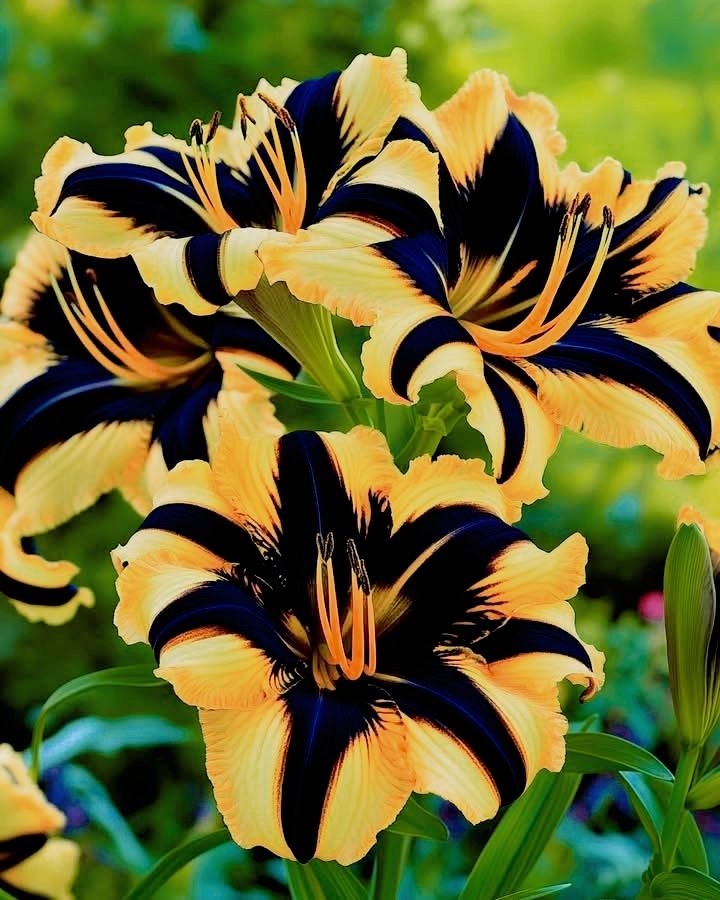The Daylily ‘Tiger Eye’ is a striking variety of daylily, known for its eye-catching, tiger-striped petals that offer a bold and exotic touch to garden landscapes. With its vibrant colors and unique patterns, this variety creates a dramatic effect wherever it’s planted, making it a perfect addition to garden beds, borders, or as a standalone feature in any outdoor space.
Blooming in mid-summer, the Tiger Eye daylily will add an intense splash of color and texture to your garden, complementing a variety of other blooms. It’s a hardy plant that thrives in full sun but can also tolerate partial shade, making it versatile for different garden setups.
Growing Conditions for Daylily ‘Tiger Eye’
1. Light: Full Sun to Partial Shade
The Daylily ‘Tiger Eye’ flourishes in full sun but can also tolerate partial shade. For the best results, plant it where it can get at least 6 hours of sunlight a day, as this encourages vigorous blooming and ensures the vibrant colors of the striped petals are showcased in all their glory. While it can grow in areas with less sunlight, you may notice fewer blooms if the plant is shaded too much.
2. Temperature: Thrives in Temperate Climates
This daylily variety performs well in temperate climates, where it enjoys moderate temperatures. It is a hardy plant that tolerates a range of temperatures, but it grows best in areas with cool to warm summers. Make sure to plant it in a location where the soil remains well-drained during wet seasons, as this helps prevent rot in cooler temperatures.
3. Watering: Water Deeply, Allow to Dry Between Waterings
The Daylily ‘Tiger Eye’ prefers a consistent watering schedule but dislikes standing water. Water the plant deeply to encourage strong root growth, and ensure the soil dries slightly between waterings. This helps avoid issues like root rot while keeping the plant hydrated. Typically, watering once a week should be sufficient, but adjust based on weather conditions and soil moisture.
4. Soil: Well-Draining, Fertile Soil
For optimal growth, plant the Daylily ‘Tiger Eye’ in well-draining soil that is rich in organic matter. A fertile, slightly acidic soil is ideal. If your soil tends to be heavy or clay-like, consider amending it with compost or organic matter to improve drainage. The well-draining soil allows the roots to grow deep and strong, preventing water from accumulating and causing rot.
5. Fertilization: Balanced Fertilizer During Growing Season
To promote lush, vibrant growth and abundant blooms, use a balanced, slow-release fertilizer during the growing season (spring and summer). Applying a light application of fertilizer every 4-6 weeks can help nourish the plant and encourage more frequent and larger blooms. Avoid over-fertilizing, as this can lead to excessive leaf growth and fewer flowers.
Additional Care Tips for Daylily ‘Tiger Eye’
Deadheading: Removing spent blooms (also known as “deadheading”) will encourage more flowers to appear throughout the blooming season. This also helps keep the plant looking tidy and healthy.
Division: Over time, daylilies may become crowded. Dividing the plants every 2-3 years will ensure they continue to thrive and bloom vigorously. Division also gives you more plants to expand your garden!
Mulching: Applying a layer of mulch around the base of the plant can help retain soil moisture, suppress weeds, and regulate soil temperature. Just be sure not to pile mulch directly against the stems, as this can encourage rot.
Pest and Disease Management: Daylilies are relatively pest-resistant, but occasionally, they may be susceptible to aphids or spider mites. Use organic insecticidal soap or a strong jet of water to remove pests. Additionally, keep an eye out for fungal diseases, which can be prevented by ensuring good air circulation around the plant.
Winter Care: Although the Daylily ‘Tiger Eye’ is hardy, it may benefit from a layer of mulch during winter to protect the roots from freezing temperatures. As the plant goes dormant in fall, cut back any dead foliage to tidy up your garden, but leave the roots undisturbed.
Conclusion: A Bold and Beautiful Addition
The Daylily ‘Tiger Eye’ is a wonderful choice for gardeners looking to add vibrant color and texture to their landscapes. With its unique tiger-striped petals, this plant brings an exotic flair to any garden, making it a standout feature in borders or beds. Thanks to its relatively low maintenance needs and ability to adapt to various growing conditions, it’s an ideal choice for both experienced gardeners and beginners.
By following these care tips and ensuring proper growing conditions, the Tiger Eye daylily will reward you with stunning blooms year after year. 🌸🐯
More Articles You Might Like
-
Texas Toast Sloppy Joes: The Crunchy, Cheesy Upgrade You Didn’t Know You Needed
There’s something timeless about sloppy joes. For generations, this saucy, savory, and slightly sweet ground beef sandwich has been a go-to comfort food in American kitchens. It’s quick, filling, and family-friendly—perfect for busy weeknights. But what if we told you there’s a way to take this classic dish up a notch? Enter the Texas Toast…
-
Classic Pig Pickin’ Cake
When it comes to Southern desserts, few sweets shine as brightly as the Classic Pig Pickin’ Cake. This nostalgic cake, sometimes called a “Mandarin Orange Cake,” has roots deep in Southern tradition. It gets its playful name from its frequent appearance at pig pickin’s—Southern-style barbecue gatherings where communities come together to enjoy slow-cooked pork, sides,…
-
Lemon Garlic Butter Chicken with Creamy Parmesan Pasta
There’s something irresistible about the combination of tender, golden-browned chicken paired with a creamy pasta coated in Parmesan cheese. Add the brightness of lemon, the depth of garlic, and the richness of butter, and you have a recipe that feels indulgent yet approachable enough for a weeknight dinner. Lemon Garlic Butter Chicken with Creamy Parmesan…



